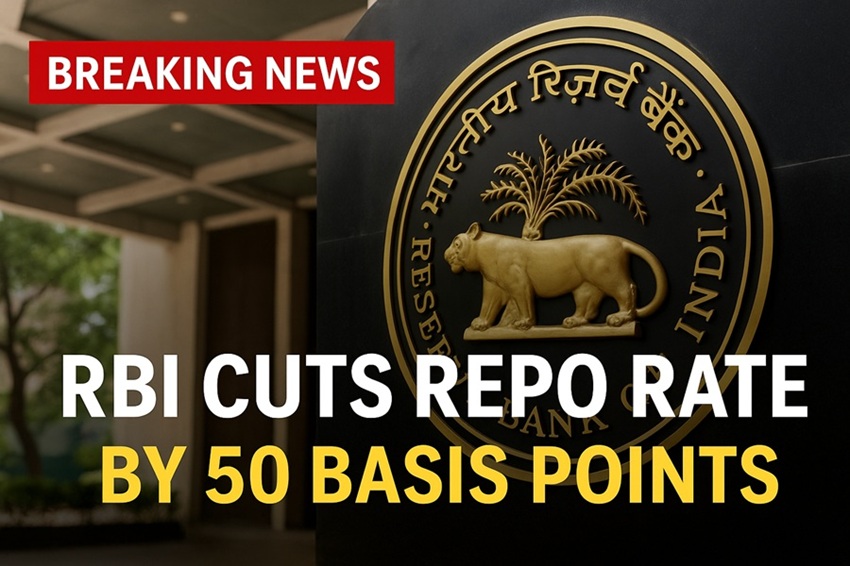In a much-anticipated move, the Reserve Bank of India (RBI) on Friday slashed the repo rate by 50 basis points (bps), bringing it down from 6.50% to 6.00%, marking the most aggressive rate cut since the pandemic era. The decision was announced after the RBI’s Monetary Policy Committee (MPC) concluded its bi-monthly meeting.
This significant monetary policy adjustment is aimed at reviving economic momentum, which has recently shown signs of softening due to global headwinds, erratic monsoon forecasts, and tightening liquidity in the domestic market.
A Strategic Move in a Challenging Global Context
With inflation gradually retreating toward the RBI’s comfort zone and India's GDP growth forecast revised slightly downward to 6.8% for FY2025-26, the central bank’s latest move underscores its intention to provide a pro-growth policy stance while maintaining macroeconomic stability.
Governor Shaktikanta Das emphasized during the press briefing, “Today’s decision reflects our assessment that monetary conditions need to be eased to support investment and consumption. It is a proactive step to ensure financial stability and promote broad-based recovery.”
Global Relevance and Market Expectations
The repo rate cut also holds relevance for foreign investors, including those from the EU and the US, who closely track India’s monetary and fiscal indicators. A lower interest rate environment typically reduces the cost of capital, thereby attracting more portfolio investments into Indian equities and government bonds. For global financial markets, India’s decision reflects a broader trend in emerging markets — balancing inflation control with growth impulses amid global economic uncertainties.
The RBI’s action comes at a time when major central banks like the European Central Bank (ECB) and the US Federal Reserve are either holding or slowly cutting interest rates after aggressive tightening cycles in 2022 and 2023. For India, the early move signals confidence in domestic macroeconomic resilience and is likely to be welcomed by both local businesses and global investors.
Why This Matters to Indian Businesses and Households
The repo rate — the rate at which the RBI lends short-term money to commercial banks — is a crucial determinant of interest rates on loans, EMIs, mortgages, and corporate credit. With today’s 50 bps cut, the immediate beneficiaries include:
Homebuyers and real estate developers: Mortgage rates are expected to decline, making home loans more affordable and reviving demand in urban and semi-urban housing markets.
MSMEs (Micro, Small and Medium Enterprises): Easier credit access will support working capital requirements, especially for export-oriented and manufacturing units facing higher input costs.
Consumers: Lower interest rates on personal loans and auto loans could spur consumption spending, especially as festive and travel seasons approach.
Corporate borrowers: Reduction in borrowing costs can enhance profitability and capital expenditure plans.
Experts believe this rate cut could serve as a liquidity booster, especially for credit-starved sectors like infrastructure, renewable energy, and rural lending.
Local People's Perspective: Relief for Households and Farmers
For ordinary citizens, particularly in rural and semi-urban India, the rate cut can translate into easier access to affordable credit. With the monsoon season approaching and agricultural input costs rising, farmers often rely on credit for seeds, fertilizers, and equipment. The move is also expected to bring some relief to urban salaried families, whose household budgets are stretched due to inflation in food, fuel, and school fees.
Sunita Devi, a homemaker from Uttar Pradesh, said, “If our EMI goes down even by ₹500 a month, that’s extra money for groceries or savings.”
Rajiv Mehta, a small textile trader in Surat, added, “Lower loan rates will help us manage our seasonal demand better. The last few quarters have been tough.”
Reactions Across Sectors
Banking Sector: Major banks including State Bank of India, HDFC Bank, and ICICI Bank have hinted at passing on the benefit to borrowers over the next few weeks.
Stock Market: The Nifty Bank index rallied 2% post-announcement, while real estate and auto stocks also surged on expectations of improved consumer sentiment.
Economists’ View: While the decision received widespread praise, some analysts cautioned about potential inflationary pressures if demand rebounds too sharply. However, with core inflation below 5%, there is room for accommodative policies, at least in the short term.
Looking Ahead
While the RBI maintains a “neutral to accommodative” stance, the central bank signaled that further rate decisions will depend on inflation data, geopolitical developments, and global crude oil prices. For now, this rate cut is seen as a bold and timely step to foster growth, consumption, and job creation in a complex global economic environment.
For the international community, especially trading partners in the EU and the US, India’s proactive monetary strategy reflects confidence in its domestic fundamentals and commitment to inclusive growth.
